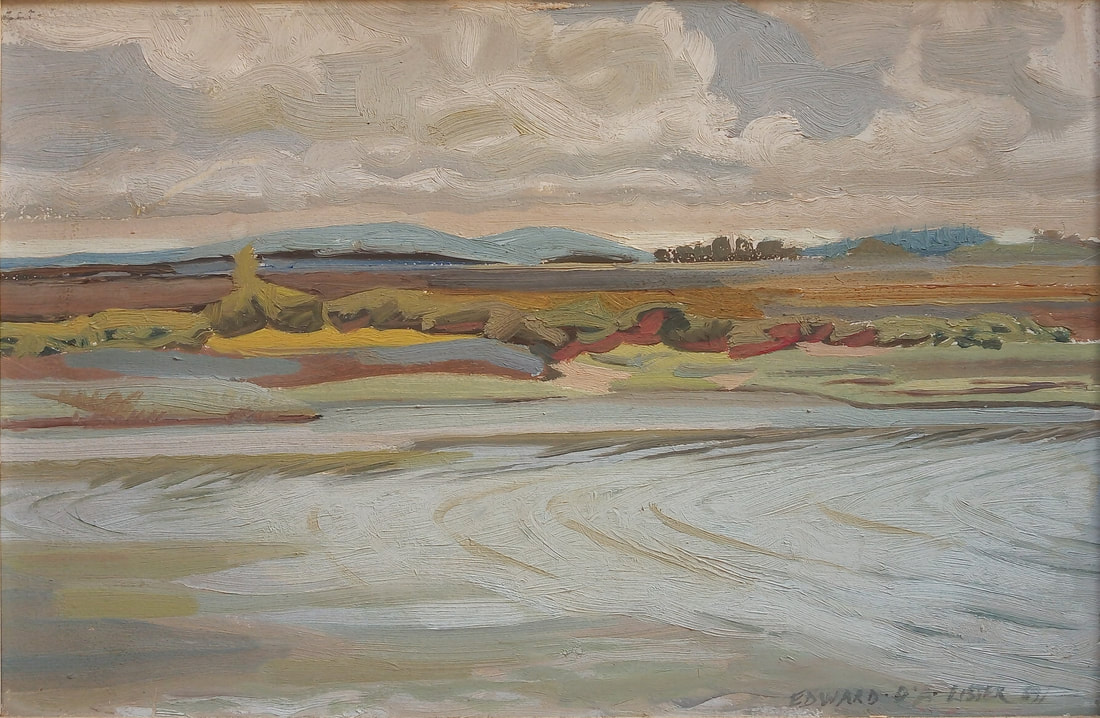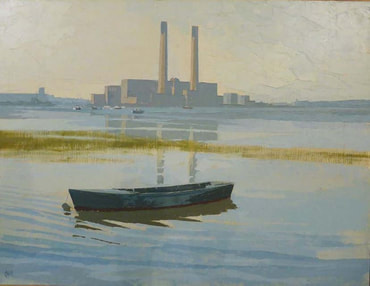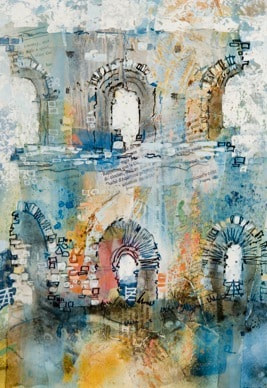|
A History of PEDAS
It all started in 1924. Well, a little before that, actually… Many artists, shaken by the trauma of war and possibly wishing to find a new perspective on life, chose to recuperate in the quieter corners of the country. HENRY LAMB MC RA (1883–1960) Henry Lamb was one such artist; he had been badly gassed on the Western Front shortly before the Armistice. He settled in the pleasant, but somewhat impoverished, fishing port of Poole, possibly wishing to be near his friends Augustus and Dorelia John. Between 1922 and 1928, Lamb lived in a 3-storey Georgian house in Hill Street, between Dear Hay Lane and Poole High Street, approximately where the multi-storey car park now stands. He kept a sailing boat in Poole harbour, and also owned a small car which enabled him to travel to the outlying villages to paint. Henry Lamb was one of the founding members of the Poole & East Dorset Art Society, contributing three paintings to the first PEDAS exhibition in 1924. Some thirteen years before this he had been involved in the Camden Town Group and then the London Group. He knew Virginia Woolf and was particularly close to Vanessa Bell. He knew Gilbert and Stanley Spencer, inviting them on several occasions to stay with him in his house in Hill Street. His paintings of the streets of Old Poole are instantly recognizable. He tended toward narrative topics depicting the activity in the town in a literal rather than expressive way. The simple geometry in the roof tops appealed to him, also the busy figures bustling past broad expanses of brown warehousing. He was very successful as a portrait artist; his most striking portrait being that of Lytton Strachey, painted before the war. Strachey was another Bloomsbury Group visitor to Poole. Henry Lamb eventually moved away from Poole when he married Lady Pansy Pakenham in 1928. He is widely represented in the Tate and many other art galleries, universities and provincial museums, including Poole. |
|
AUGUSTUS JOHN RA, OM (1878-1961)
When he settled in Dorset in 1910, Augustus John plunged whole-heartedly into the bohemian lifestyle. Living in Alderney Manor, on Ringwood Road, Parkstone with his wife and several children, he proceeded to turn the place into a romantic commune, inviting anybody who was somebody to stay. Henry Lamb, the Bloomsbury group, the Spencers; they all came and camped in the colourful gypsy caravans that dotted the 60 acre heath that in those days surrounded the manor. Augustus John would paint small, but colourful, pochade panels in response to the landscape around him - including Canford Heath. These were usually preparations for larger works. Known to disappear from time to time, on romantic forays, he nevertheless remained in Poole long enough to help set up the Poole and East Dorset Art Society, and contributed two paintings to the 1924 exhibition. Whilst in Poole, The Sea View pub and the Lord Nelson were two of his favourite haunts. A small, blue plaque on the quay commemorates these visits. In his time, this flamboyant, charismatic artist acquired a reputation as the most sought after society portrait painter of the day. By the bridge at Fordingbridge, there's an impressive piece of sculpture by Ivor Roberts-Jones showing the older, stiff-limbed Augustus John. |
BERNARD F GRIBBLE RBC SMA (1872 - 1962)
The longevity of Poole and East Dorset Art Society seems to stem from its inclusiveness & diversity. Bernard Gribble was a very different character from the bohemian Augustus John. Whilst the latter had a penchant for romantic adornments such as gold earrings, Gribble was always formal in countenance and dress, and known to wear white spats over his boots!
He exhibited with PEDAS in 1929 even though, according to our catalogues, he was at the time, still living in London. By 1932, however, he had moved to Springfield Crescent, Parkstone where he was to become a prominent local resident and a leading member of PEDAS. He served for many years as a popular and sociable Chairman and vice-President of our Society. Gribble was 60 by the time he moved to Poole and was already well known as a painter of historical, sometimes romanticized, maritime themes. A regular exhibitor at the Royal Academy and at the Paris Salon his paintings were widely sought. His large oil paintings were collected by Rooseveldt, George V and later, Jackie Onassis.
Early 2014 saw Poole Museum stage an exhibition of his maritime paintings. Bernard Gribble is buried with his wife in Parkstone Cemetery, Poole.
The longevity of Poole and East Dorset Art Society seems to stem from its inclusiveness & diversity. Bernard Gribble was a very different character from the bohemian Augustus John. Whilst the latter had a penchant for romantic adornments such as gold earrings, Gribble was always formal in countenance and dress, and known to wear white spats over his boots!
He exhibited with PEDAS in 1929 even though, according to our catalogues, he was at the time, still living in London. By 1932, however, he had moved to Springfield Crescent, Parkstone where he was to become a prominent local resident and a leading member of PEDAS. He served for many years as a popular and sociable Chairman and vice-President of our Society. Gribble was 60 by the time he moved to Poole and was already well known as a painter of historical, sometimes romanticized, maritime themes. A regular exhibitor at the Royal Academy and at the Paris Salon his paintings were widely sought. His large oil paintings were collected by Rooseveldt, George V and later, Jackie Onassis.
Early 2014 saw Poole Museum stage an exhibition of his maritime paintings. Bernard Gribble is buried with his wife in Parkstone Cemetery, Poole.
SIR GERALD KELLY KCVO PPRA (1879 – 1972)
Sir Gerald Kelly served for three decades as President of the Poole and East Dorset Art Society - from 1934 to 1964 - but his reputation spread far beyond the boundaries of Poole. He was also President of the Royal Academy from 1949 to 1954.
He had been educated at Eton College and Trinity Hall, Cambridge before going on to study Art in Paris. He enjoyed a reputation as a prominent academic painter and was official portrait artist to the Royal Family. He received numerous accolades in a long and distinguished career and was knighted in 1945.
Sir Gerald lived in London but travelled widely to paint in exotic and interesting places, still finding time, however, to exhibit on innumerable occasions with our Society here in Poole.
Sir Gerald Kelly served for three decades as President of the Poole and East Dorset Art Society - from 1934 to 1964 - but his reputation spread far beyond the boundaries of Poole. He was also President of the Royal Academy from 1949 to 1954.
He had been educated at Eton College and Trinity Hall, Cambridge before going on to study Art in Paris. He enjoyed a reputation as a prominent academic painter and was official portrait artist to the Royal Family. He received numerous accolades in a long and distinguished career and was knighted in 1945.
Sir Gerald lived in London but travelled widely to paint in exotic and interesting places, still finding time, however, to exhibit on innumerable occasions with our Society here in Poole.
ARTHUR ANDREWS, ARCA, FRSA., NRD (1906 – 1966)
Arthur Andrews is warmly remembered by PEDAS members for initiating ‘The College Art Collection’. As Principal of the College he secured funding, at a time of great austerity, for the purchase of artworks for the benefit of both students and, it is widely documented, for the people of Poole. The artworks purchased included work by Henry Moore, Ivon Hitchens, and Jacob Epstein. As time went by the Collection was gradually added to until it held works by many of the major British artists of the mid-20th century. The grants for these purchases continued until Arthur’s death in 1966.
As the need arose to house the Collection, members of PEDAS raised a considerable sum towards the realization of The Study Gallery, which opened formally in 2000. The Arts and Education were always Arthur’s main concern while his own specialism was in commercial & industrial design. Our catalogues show that in 1948 he served on the Poole and East Dorset Art Society Organising Committee and occasionally took part in the exhibitions.
Sadly, the majority of the The College Collection has now gone. Key pieces such as the Henry Moore, Ivon Hitchens ‘Spring Landscape with Pond and a House’, Carel Weight’s ‘Jane’ and other artworks and lithographs by Graham Sutherland, Bridget Riley, Patrick Heron and John Piper were recently sold - and the Study Gallery is now used for other purposes.
Our Society has always had close links with the College. Many lecturers and students from the Poole College of Art, as it previously was, became key members of our Society.
Arthur Andrews is warmly remembered by PEDAS members for initiating ‘The College Art Collection’. As Principal of the College he secured funding, at a time of great austerity, for the purchase of artworks for the benefit of both students and, it is widely documented, for the people of Poole. The artworks purchased included work by Henry Moore, Ivon Hitchens, and Jacob Epstein. As time went by the Collection was gradually added to until it held works by many of the major British artists of the mid-20th century. The grants for these purchases continued until Arthur’s death in 1966.
As the need arose to house the Collection, members of PEDAS raised a considerable sum towards the realization of The Study Gallery, which opened formally in 2000. The Arts and Education were always Arthur’s main concern while his own specialism was in commercial & industrial design. Our catalogues show that in 1948 he served on the Poole and East Dorset Art Society Organising Committee and occasionally took part in the exhibitions.
Sadly, the majority of the The College Collection has now gone. Key pieces such as the Henry Moore, Ivon Hitchens ‘Spring Landscape with Pond and a House’, Carel Weight’s ‘Jane’ and other artworks and lithographs by Graham Sutherland, Bridget Riley, Patrick Heron and John Piper were recently sold - and the Study Gallery is now used for other purposes.
Our Society has always had close links with the College. Many lecturers and students from the Poole College of Art, as it previously was, became key members of our Society.
|
EDWARD D’ARCY LISTER ARCA (1911–1976)
The lively wood & linocuts that decorate the PEDAS exhibition catalogues of the 1950s, 60s and 70s are the work of Edward Lister. He taught at the local Art School having studied under Gilbert Spencer at the Royal College of Art. A highly accomplished artist, the paintings and collages Edward produced are bold and distinctive, interpretations of the character and rhythm of a landscape. Dennis Hill remembers Edward as an inspiring artist and teacher, as well as someone with a great sense of humour. He recalls an incident when Edward was standing in the gallery by his painting: ‘A Dorset Coast’ wishing to find a light for his cigarette. He turned to his picture, spotted a small piece of sandpaper amongst the collage – and promptly struck his match upon it. Sometime in the 1960s Edward Lister became President of PEDAS, until his early death in 1976. When Edward died PEDAS bought and presented ‘A Dorset Coast’ to the Poole Art Centre. When the Centre was refurbished this wonderful picture was thrown into a skip - but fortunately rescued by Brian Tofield. It is now being looked after by Dennis. |
|
DENNIS HILL (1924 - 2024)
Dennis joined PEDAS in the early 1960s and became a key member of the club, serving as Treasurer for some years. We all knew him as a very generous, gifted and prolific artist. Born in 1924, we were intending to celebrate both the club’s centenary and his own100th birthday. Dennis described his early years: “When I was seven, I started reading avidly any book or magazine on painting I could lay my hands on. I came across the magazine called The Studio which must have been the forerunner of The Artist. I continued drawing and I was quite prolific until courtship, career and the war slowed me down. It was later that I went to evening classes for life drawing and met Edward Lister, who taught me to paint and to ‘see’. He opened my eyes and became a great influence on my development”. We can’t resist quoting Dennis on his approach to painting: “My approach is pretty simple. For me there is nothing like painting on the spot. My aim is to produce something with impact, uncomplicated and yet direct. When I see something that excites me, be it a flash of light on the bark of an old tree, an old boat beached at a funny angle, or an old oil drum being used as an incinerator, this will be my starting point and all my energy will be directed on it. All other features will be sublimated and repositioned to dramatize this main interest. I call this "design" and of course this is just what it is. I am generally not interested in just recording. Light plays an important part in all this too. I suppose my motto would be, keep it simple and clean, and don't even think about failure, but accept it if it happens.” Dennis recalled an incident when he was younger - whilst painting on location at the water’s edge in Poole and responding to the scene in front of him, when a dockworker approached and told him he remembered seeing Augustus John sitting in that same spot painting the very same view many years ago! Dennis best known for his watercolours, also painted in oils and acrylics. He had work exhibited at: The Royal Institute of Painters in Watercolour (RI) at the Mall (uninterrupted over 20 years); The Royal West of England Academy (RWA) Bristol; The Royal Society of Marine Artists (RSMA) London and The Royal Society of Watercolour Artists (RWS), Bankside. His work has been bought and held by: Poole Maritime Museum, Royal Ordinance Survey, Dorset County Council, British Petroleum, Russell Cotes Art Gallery and Museum, Bournemouth and Longleat House, Wiltshire. He has had solo exhibitions at ‘The Gallery’, Dorchester; the ‘Peter Hedley Gallery’ and the ‘Acanthus Gallery’, both at Wareham. A very popular much loved artist who we will all miss but can treasure his wonderful art. |
|
RICHARD PRICE ROI ( -2018)
Richard Price was member of the Royal Institute of Oil Painters and sold his work in London and internationally. He also exhibited at the Royal Academy of Arts and the Royal College of Arts. Richard’s work is concerned with light and atmosphere and falls within the traditions of artists such as Turner and Walter Sickert. While some of his work was done in the studio, Richard was predominantly an ‘en plain air’ painter and most of his work was therefore painted immediately in front of his subject. The challenge of this type of work is in being able to rapidly analyse colour and tone at the same time as capturing the constantly moving drama of the environment. |
|
JOHN BOWEN NDD, Cert RAS (1940 - 2020)
As President of the Poole and East Dorset Art Society - “In 1980, when I arrived in Poole, both Poole and East Dorset Art Society and the Art Section, to which I had been appointed, at The Bournemouth and Poole College of Further Education, were at a low ebb. PEDAS was finding it hard to reconcile its reputation with its need for new members and the Art Section at The College had been consigned to one studio some distance from the main site. The College’s significant Art Collection languished in a store cupboard with a few exceptional pieces on display. When, in the early 80’s, I was asked to be President of PEDAS, and with Peter Hardwick in the chair, the society began to develop a more inclusive approach to new members. Sometime later it attracted a group of mature ‘A’ level art students attending the growing number of courses at the College. Over many years the drive and tireless enthusiasm of these, and others who have joined them, has sustained and grown PEDAS into what it is today.” As Artist “Born in 1940 and educated at Magdalen College School, High Wycombe School of Art, The Byam Shaw School of Drawing and Painting and The Royal Academy Schools, I practiced as a portrait painter for several successful years. My work was exhibited at the Royal Academy, The Royal Scottish Academy, The Royal Society of Portrait Painters and others. I came to Poole in 1980 from Langley College of Further Education where I had been teaching classes in Portraiture, Life Drawing, Ceramics, Screen Printing, Drawing and Painting. It may have been my training and exhibiting which qualified me for the rather grandly titled post of Lecturer in Charge of Fine Art Studies! However, it was the responsibility for the College Art Collection which gave this post a special appeal to me. The educational value of the Collection led to a sustained effort by many to have a gallery built, known initially as The Study Gallery. The Collection is now dispersed. The gallery used for other purposes.” John recorded 2 audio cd's which he called "Jottings from an Active Life". Click or tap a link below to listen to these recordings: Part One - Part Two |
Sources: PEDAS Exhibition Catalogues since 1924; ‘Art in Dorset’ by Peter Davies published by Poole Historical Trust; ‘The College Art Collection & The Study Gallery Poole’ by Roy S Hall
Poole & East Dorset Art Society (PEDAS) is a Charitable Incorporated Organisation, Registered Charity no 1184632
All content © PEDAS 2025
All content © PEDAS 2025











